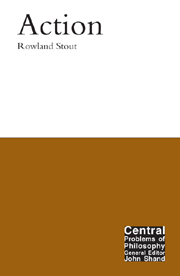Book contents
- Frontmatter
- Contents
- Acknowledgements
- 1 Introduction: inward-looking and outward-looking approaches to agency
- 2 Acting for a reason
- 3 Reasons and passions
- 4 Agent causation
- 5 Mental causation
- 6 Deviant causal chains and causal processes
- 7 Acting with an intention
- 8 Prior intention
- 9 The metaphysics of action
- Conclusion
- Notes
- Suggestions for further reading
- References
- Index
1 - Introduction: inward-looking and outward-looking approaches to agency
- Frontmatter
- Contents
- Acknowledgements
- 1 Introduction: inward-looking and outward-looking approaches to agency
- 2 Acting for a reason
- 3 Reasons and passions
- 4 Agent causation
- 5 Mental causation
- 6 Deviant causal chains and causal processes
- 7 Acting with an intention
- 8 Prior intention
- 9 The metaphysics of action
- Conclusion
- Notes
- Suggestions for further reading
- References
- Index
Summary
Being an agent
At the very heart of our conception of what it is to be a person is the idea that we (as people) are both subjects and agents. Being subjects of experience, we are conscious of ourselves and our world. We are receptive to the way things are, and have perceptual and emotional experiences as part of that receptivity. But we also act on our world. We change it in the light of our reasons. We are agents as well as subjects: active as well as passive. Action and experience, agency and consciousness, hand in hand make up our very nature.
The properties of being an agent or a subject come in varying degrees. At the most minimal level we might think of the sun as an agent in the process of warming up a stone, or of a planet as subject to the force of gravity. And at the other extreme we have full-blown agency and consciousness. A person is the full-blown agent of an intentional achievement when they write a book. And they are the full-blown subject of conscious experience when they watch the sun set, attending to every shifting pattern of colour in the clouds.
There are intermediate cases. A sunflower turns to face the rising sun. This is an action in some sense. And although the behaviour of the sunflower is not deliberate, it is not accidental either. It is directed to the goal of its bloom facing the rising sun.
- Type
- Chapter
- Information
- Action , pp. 1 - 14Publisher: Acumen PublishingPrint publication year: 2005

